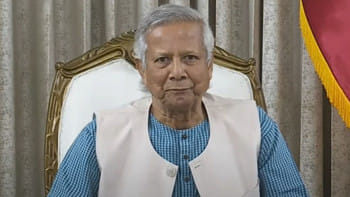Women at War: Shongramee Naree 52 and 71

Since the Liberation War in 1971 the readers in Bangladesh have seen many narratives on 1971 and 1952. In most of these, the central characters are men or young boys, while women play important roles in relatively fewer ones. Shongramee Naree 52 and 71, edited by Bashar Khan is an interesting and thought provoking collection published by the Star Books as it records not narratives but interviews of women who struggled during those days. While some of these women are wives and mothers of the freedom fighters, many were fighters themselves. The interviews allow them to speak for themselves and address the audience directly. Some of the interviews in this collection were published before in other books, but some are painstakingly collected for this special volume.
In the foreword of the book, the editor observes how interviews play a significant role in recording history. It is very true that at different times the history of our nation has been modified by various political parties and hence "oral history" can come to play a significant role. Divided into two parts, the first section of this collection showcases interviews of women who walked the road with fellow students and protesters in 1952. Most of the interviewees were students back then. The first piece records Prof. Sharifa Khatun's experience during the Language Movement. She was a student of Eden College at that time and resided at the college hostel. She recounts how she, along with other students, participated in the rally of 21 February, the detailed planning of the student body, the police attack on the protesters and the deaths of a number of students who later were recognized as the language martyrs. Rowshan Ara Bachchu's interview recounts the happenings of those days. A staunch bhasha shainik, Rowshan Ara portrays the background of the Language Movement and how the West Pakistanis deprived their brethren of East Pakistan in various fields. She surely was among the students on that fateful day of 21 February and stood against the police in the streets. It is quite clear from the interviews that many women were closely connected with the Language Movement and a number of them were imprisoned in the aftermath. Some were reprimanded by their family members, and some were forced to give up their studies even.
The interviews recorded in the collection are clear and vivid with pictures of the interviewees. It is apparent that most of them still cherish the memories as something precious and unforgettable. They indeed feel connected with the making of history. Among the other women recounting their experience, there are Prof. Laila Noor, Jowshan Ara Rahman, Taleya Rehman, Ayesha Akter Khatun Belu, Protibha Mutsuddi, Prof. Afzalunnesa and Amena Begum.
The second part of the interviews records a heart-rending aspect of the Liberation War. Starting with Fazilatunnesa Mujib whose husband left her with instructions of raising the children properly in the wake of the War, the collection is about tales of women helping the freedom fighters, women whose husband and children were killed in front of them, women who lost everything in the War. There are tales of women who were left with next to nothing to live on. Most of them were young women who received very little help from the government or the state. One of them was a mere child, but was not spared. Like the women participating in the Language Movement, they too came from different walks of life and the common characteristic among these war heroines is that they are all women and they all paid dearly for the freedom of their country.
An important fact that emerges from reading the book is that most of these women from '71 have gone unrecognized by the nation. With the exception of a few they have ended in destitution. One might wonder after reading this book what will help all those women that are integral part of our national identity. One might also wonder if a nation is capable of appreciating its liberation when it cannot honor the men and women who paid the highest price for the same liberation.
The appendix of the book focuses on an aspect that is connected to the heroic women and our history-- the war babies of 1971, most of whom were adopted by families from foreign countries. Just as nobody knows the exact number of the people killed in the Liberation War, or the number of raped women, the number of the war babies also remains unknown. This chapter records the interview of two war babies who have become successful in life but they return to Bangladesh in search of their roots.
The best aspect about Shongramee Naree 52 and 71 is that it depicts the harrowing tales without indulging in sensationalism. There are photographs that bring authenticity to the narrations and interviews. The only reservation I have about this book which is indeed a commendable effort, is that the language is often not very lucid. There are narrations that have not been carefully edited and hence sometimes the sentences appear choppy. Nevertheless, it deserves to stand out among the books documenting the struggles of freedom on part of Bangladesh.
Sohana Manzoor is Assistant Professor of English at the University of Liberal Arts, Bangladesh. She is also the Editor of the Star Literature and Review Pages.


 For all latest news, follow The Daily Star's Google News channel.
For all latest news, follow The Daily Star's Google News channel. 



Comments